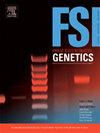津巴布韦人群中单亲本谱系的人种地理结构评价
IF 3.1
2区 医学
Q2 GENETICS & HEREDITY
引用次数: 0
摘要
对于大多数非洲国家来说,津巴布韦在人类基因研究中的代表性不足,关于其人口中单亲血统组成的信息很少。因此,为了调查津巴布韦人的父系遗传,本研究使用mtDNA和y染色体特异性标记对来自最具代表性的民族语言群体的479个样本进行了分析。基于Guthrie’s Bantu Zone Classification和地理学对样本进行分组,利用FST遗传距离和AMOVA对样本进行亚结构分析。根据这些结果,可以得出结论,除了卡兰加族显示出种族和地理隔离的证据外,津巴布韦人口并没有保持高度的分层。为了进一步研究津巴布韦男性谱系的组成,使用negen软件使用Y-STR单倍型预测所有样本的单倍群。共有64个低于预测置信阈值的样本和73个高于预测置信阈值的随机样本进行了y - snp的分型。对于低于置信阈值的样本,negen和Y-SNP结果之间的巧合只有67% %的病例。对于预测单倍群高于置信阈值的样本,Y-SNP基因分型显示两个错误分类。这一结果表明,Y-SNP分型对于在遗传研究中代表性不足的人群中定义单倍群仍然是必不可少的。本文章由计算机程序翻译,如有差异,请以英文原文为准。
Evaluation of ethnogeographic structuring of uniparental lineages in Zimbabwean populations
As for most African countries, Zimbabwe is underrepresented in human genetic studies, with little information available on the uniparental lineages’ composition of its populations. Therefore, with the aim of investigating the maternal and paternal inheritance of Zimbabwe, 479 samples from the most representative ethnolinguistic groups were analyzed in this study, using mtDNA and Y-chromosomal specific markers. Population substructure was investigated by mean of FST genetic distances and AMOVA, after grouping the samples based on Guthrie's Bantu Zone Classification and geography. Based on the results, it was possible to conclude that the Zimbabwean populations do not maintain a high stratification, except for the Kalanga group that shows evidence of ethnic and geographic isolation. To further investigate the composition of Zimbabwean male lineages, Y-STR haplotypes were used to predict the haplogroups of all samples using the NEVGEN software. A total of 64 samples below the prediction confidence threshold, as well as 73 random samples above it, were typed for Y-SNPs. For samples below the confidence threshold, there was a coincidence between the NEVGEN and Y-SNP results in only 67 % of cases. For samples with predicted haplogroups above the confidence threshold, Y-SNP genotyping showed two misclassifications. This result demonstrates that Y-SNP typing is still essential for defining haplogroups in populations that are underrepresented in genetic studies.
求助全文
通过发布文献求助,成功后即可免费获取论文全文。
去求助
来源期刊
CiteScore
7.50
自引率
32.30%
发文量
132
审稿时长
11.3 weeks
期刊介绍:
Forensic Science International: Genetics is the premier journal in the field of Forensic Genetics. This branch of Forensic Science can be defined as the application of genetics to human and non-human material (in the sense of a science with the purpose of studying inherited characteristics for the analysis of inter- and intra-specific variations in populations) for the resolution of legal conflicts.
The scope of the journal includes:
Forensic applications of human polymorphism.
Testing of paternity and other family relationships, immigration cases, typing of biological stains and tissues from criminal casework, identification of human remains by DNA testing methodologies.
Description of human polymorphisms of forensic interest, with special interest in DNA polymorphisms.
Autosomal DNA polymorphisms, mini- and microsatellites (or short tandem repeats, STRs), single nucleotide polymorphisms (SNPs), X and Y chromosome polymorphisms, mtDNA polymorphisms, and any other type of DNA variation with potential forensic applications.
Non-human DNA polymorphisms for crime scene investigation.
Population genetics of human polymorphisms of forensic interest.
Population data, especially from DNA polymorphisms of interest for the solution of forensic problems.
DNA typing methodologies and strategies.
Biostatistical methods in forensic genetics.
Evaluation of DNA evidence in forensic problems (such as paternity or immigration cases, criminal casework, identification), classical and new statistical approaches.
Standards in forensic genetics.
Recommendations of regulatory bodies concerning methods, markers, interpretation or strategies or proposals for procedural or technical standards.
Quality control.
Quality control and quality assurance strategies, proficiency testing for DNA typing methodologies.
Criminal DNA databases.
Technical, legal and statistical issues.
General ethical and legal issues related to forensic genetics.

 求助内容:
求助内容: 应助结果提醒方式:
应助结果提醒方式:


